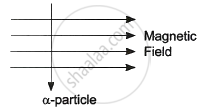Advertisements
Advertisements
Question
An alpha particle enters a uniform magnetic field as shown. The direction of force experienced by the alpha particle is ______.

Options
towards right
into the page
towards left
out of the page
Solution
An alpha particle enters a uniform magnetic field as shown. The direction of force experienced by the alpha particle is out of the page.
Explanation:
According to Fleming's Left-Hand Rule, the current flows in the direction of the alpha particle, the field points in the direction of the paper's right side, and the force is directed out of the paper by the thumb.
RELATED QUESTIONS
State Fleming's left hand rule.
List three ways in which the magnetic field strength of a current-carrying solenoid can be increased?
In a statement of Fleming's left-hand rule, what do the following represent?
(a) direction of centre finger.
(b) direction of forefinger.
(c) direction of thumb.
The following diagram shows two parallel straight conductors carrying the same current. Copy the diagram and draw the pattern of the magnetic field lines around them showing their directions. What is the magnitude of the magnetic field at a point 'X' which is equidistant from the conductors? Give justification for your answer.

The north pole of Earth’s magnet is in the ____________.
The strength of magnetic field around a current-carrying conductor is ____________.
Observe the given figure of Fleming's Left Hand Rule and write the labels of 'A' and 'B':

Two LED bulbs of 10W and 5W are connected in series. If the current flowing through 5W bulb is 0.005A, the current flowing through 10W bulb is ______.
If the strength of the current flowing through a wire is increased, the strength of the magnetic field produced by it ______.
A copper conductor is placed over two stretched copper wires whose ends ate connected to a D.C. supply as shown in the diagram.
- What should be the magnetic poles at the points A and B lying on either side of the conductor to experience the force in the upward direction?
- Name the law used to find these polarities.

